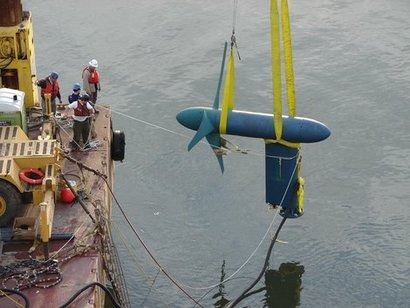
It is the first time that the government-backed Catapults and Innovation Centres have worked together. The aim is to improve the monitoring of activity around subsea tidal installations and provide a warning when there is a risk of collision with a tidal device. The project partners will assess whether sensor technology from other industries can be employed to detect, monitor and forewarn of potential collisions or whether a new type of sensor is needed.
Current monitoring processes can be very expensive as they involve teams of watchers on the seashore and a mixture of subsea listening devices. The cost of subsea environmental monitoring can therefore be substantial and it can also prove inconclusive when it is difficult to confirm surface sightings with events beneath the waves. Regulations stipulate that developers must analyse the environment around a proposed site for two years prior to installation, as well as during the construction phase and throughout the plant’s operation. This is likely to be at least 20-25 years.
“Tidal energy is an emerging market with great export potential, which the UK has the potential to lead” said Vicky Coy, Project Manager at ORE Catapult. “We have some of the best tidal resources around the UK and are already at the forefront of industry research, leading in the design and demonstration of this technology. Scotland, in particular, has a number of rich tidal energy sites with the Pentland Firth and Orkney Waters among the greatest in the UK.”
Ms Coy added that the primary concern is safety, both of the natural environment and the equipment. In order to achieve that, reliable monitoring systems have to be designed in order to provide confirmation that the devices can be comfortably integrated into the subsea environment. However, this also has to be achieved cost effectively and so another aspect of the project is to simplify and reduce the costs involved in what is, in effect, a subsea equivalent of the planning process.
Tidal energy developers tend to be small and medium-sized companies with limited resources, so any costs which can be removed at the same time as improving safety will be welcomed by the industry. There has been a lot of positive engagement from both the business and academic communities, and the collaboration partners are now looking to harness this support further when they move to the next stages of the initiative.
At present, there are a number of developments in the tidal energy market that are at various stages of the planning process. The first of these, and the most high profile, is the MeyGen project located in the North of Scotland. This is aiming to deploy up to 398 MW of offshore tidal stream turbines by the early 2020s.
Gavin Burrows, Project Manager at CENSIS said that the project is working with a number of organisations to articulate the needs for a sensor system with the appropriate sensitivities - one that can provide evidence of how marine mammals behave near tidal turbines and also determine what exactly has impacted on a particular asset, should a collision occur. It’s most likely that sensors, whether these are brought in from another industry or developed specifically for this purpose, will be built into the blades of subsea turbines. This could have applications in a range of other offshore devices, not just in the tidal energy market.
“There is significant potential for us to export the skills and expertise we’ll be developing as part of this project – particularly as we move into the demonstration and commercialisation phases” Mr Burrows added. “Likewise, researchers will have access to new and hitherto untapped data, giving them the opportunity to accelerate the industry. The potential is there for our academic and business communities to take further leaps forward in the tidal energy market – our aim is to make this happen and create economic value out of the research for Scotland.”
CENSIS is the Scottish Centre for Sensors and Imaging Systems, which aims to bring together commercial innovation and academic research, to drive economic activity in Scotland. It was established in April 2013 with an initial £10 million funding and expects to deliver 150 collaborative R&D projects while assisting Scotland’s 170 companies in the industry which, between them, contribute £2.6 billion to the economy. It is funded by the Scottish Funding Council, with additional support from the Scottish Government, Scottish Enterprise and Highlands & Islands Enterprise.
The Innovation Centres, which were launched in 2014 and in the latter part of 2013, sit within the construction industry, oil and gas, stratified medicine, digital health, industrial bio-tech, and sensors and imaging. Each Centre aims to establish bonds between Scotland’s universities and their respective industry sectors, translating the knowledge and expertise into commercially viable products and companies to benefit the country’s economy.
For additional information:

